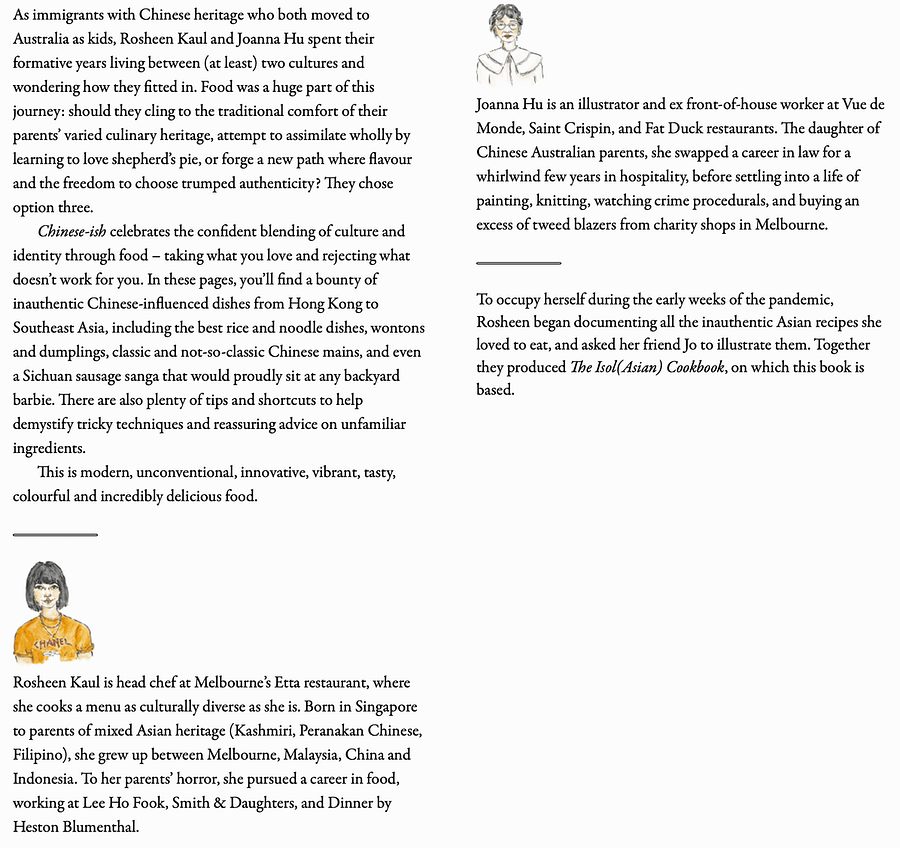I’d not known that the Aussie “sanga” was their own slang version of “sarnie” (or sandwich for the posh twats out there), until I came across mention of it in this recipe in “Chinese-ish: Home Cooking, Not Quite Authentic, 100% Delicious” by Rosheen Kaul & Joanna Hu. It’s one of a number that they’ve written about where they describe them as
“snacks that feel kinda wrong..”
The feel of this book is so very similar (not in any derivative fashion I hasten to add — no Elizabeth Haigh knock-off this — simply just because of the background of the writers) to others I’ve talked about recently by other immigrants and diaspora children. Angela Hui in Wales, Linda Lau Anusasananan from California, Archan Chang, a Hong Kong “local”, Da-Hae, England via Korea, Roy Choi, Korean Californian etc. etc. The list — and the reading — goes on and on but their description of how they feel, how they fit (or often don’t) into the community in which they find themselves, their relationship with their parents and relatives (often a continent and an unknown culture away) and with food, their own, local, country based food and that from their own background, the latter that is often seen as something to be vaguely ashamed of or hidden in order that one can fit in.
But it’s not a bad mantra they’ve come up with where flavour — and their freedom to choose — trumps any feeling that they need to strive for some chimera of ‘authenticity’.

Anyway, the recipe is headlined as below; a fine amalgam of Australia and China:
“I love a ‘sausage sizzle’, as we call them in Australia, where you can grab a barbecued, slightly singed snag (sausage) wrapped in soft white bread, in exchange for a gold coin. This recipe keeps the sizzle, the sausage and the white bread, but the similarities end there. Instead, a flavourful, juicy, Sichuan peppercorn-spiced pork sausage is studded with guanciale, smeared with Japanese mayonnaise and refreshed with lime juice. Definitely not your average sausage sanga.”

SERVES 4
450 g (1 lb) pork mince (ground pork)
50 g (1¾ oz) guanciale or pancetta, finely chopped
2 teaspoons grated ginger
2 tablespoons fish sauce
1 tablespoon light soy sauce
1 tablespoon Dijon mustard
2 teaspoons caster (superfine) sugar
1 tablespoon cornflour (cornstarch)
1 teaspoon iced water
Vegetable oil, for shallow frying
SPICE MIX
3 teaspoons Sichuan or Korean chilli flakes
2 teaspoons Sichuan peppercorns
1 teaspoon ground white pepper
½ teaspoon cumin seeds
½ teaspoon coriander seeds
½ teaspoon ground turmeric
TO ASSEMBLE
4 slices white bread
Coriander (cilantro) leaves
Mint leaves
Kewpie mayonnaise
Lime wedges
PREPARATION
Place the pork mince in the freezer for 30 minutes before using.
To make the spice mix, place all of the ingredients in a small frying pan and toast over low heat until very fragrant, taking care not to burn the chilli flakes. If they turn too dark, start again. Set aside to cool, then blitz into a fine powder using a food processor.
Add the chilled pork mince, guanciale, ginger, fish sauce, light soy sauce, Dijon mustard, sugar, cornflour and iced water to the spice mix and pulse until combined. The mixture should bounce back when pressed. Refrigerate the sausage mixture for 2 hours.
Using wet hands, roll the sausage mixture into four 2 cm x 10 cm (3/4 inch x 4 inch) logs and refrigerate for at least 1 hour to set.
Heat a frying pan over medium heat and add enough vegetable oil to evenly coat the base of the pan. Cook the sausages until they are a deep golden-brown, rolling them around continuously for about 10 minutes.
To assemble, wrap the sausages in white bread with a generous handful of fresh herbs, a decent smear of mayonnaise and a good squeeze of lime juice.